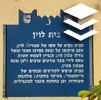
The ultimate street signs, historical sites and house numbers
 Click for a larger image
Click for a larger image  Click for a larger image
Click for a larger image  Click for sign's details
Click for sign's details  Click for all signs belonging to Heritage Sites in Israel
Click for all signs belonging to Heritage Sites in Israel
 The closest sign from this series (533 Meter): Rehovot - Heritage Sites in Israel - Haskelberg House
The closest sign from this series (533 Meter): Rehovot - Heritage Sites in Israel - Haskelberg House 
 662 Meter |
662 Meter |  1.25 Km |
1.25 Km |  1.77 Km |
1.77 Km |  1.84 Km |
1.84 Km |  1.85 Km
1.85 Km